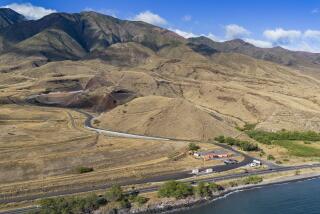Ordnance Cleanup Begins Healing of Hawaiian Island
- Share via
HONOKANAI'A BAY, Hawaii — No longer used for target practice by the Navy, Kahoolawe is an island on the mend. But Native Hawaiian leaders say it will take generations to undo the damage five decades of bombardment and other interference by humans have wrought.
The Navy this week offered reporters their first close look at an ordnance-removal effort that began two years ago and is scheduled to end in 2003.
On display were some of the 1 million pounds of bombs and fragments recovered so far in what Navy officials said is the largest project of its kind ever undertaken by the U.S. military.
Crews also detonated a 2,000-pound bomb--the largest found so far in the cleanup--in a blast heard more than two miles away.
The cleanup pumps $40 million a year into Maui County’s economy and has made it possible for Hawaiian groups to use some of the island for cultural and educational activities.
But there is a long way to go in restoring Kahoolawe to its long-ago shape, as the island’s current stewards confront a host of other problems, including soil erosion that has killed off native plants and related runoff problems that have dirtied surrounding waters, damaged coral reefs and depleted fish stocks.
“The ordnance removal is the first step in that long process of healing this island,” said Keoni Fairbanks, executive director of the Kahoolawe Island Reserve Commission. The state agency is responsible for setting policy and making long-term plans to turn the island into a Hawaiian cultural reserve.
Six miles southwest of Maui, Kahoolawe is the smallest of the eight major Hawaiian islands at 45 square miles. It is 11 miles long and 7 miles wide, with its highest point at 1,480 feet.
Steep cliffs line the southern and eastern coastlines. The northern and western sides slope toward footstep-free beaches and bays. In between, a bumpy dirt road winds through barren patches of deep red, milky brown and purple-gray earth easily kicked up by winds that top 50 miles per hour.
Thorny kiawe trees provide most of the island’s greenery.
Experts say the loss of vegetation began with ranchers’ introduction of goats in the late 18th century. The Navy has removed the goats.
The Navy used Kahoolawe as a target and training area from 1941 until 1990, when President George Bush ordered a halt to the exercises after years of protests and lawsuits by Native Hawaiian groups.
Congress in 1993 agreed to spend up to $400 million through November 2003 to clear the ordnance and required Kahoolawe’s return to local control.
The original cleanup plan called for removal of 100% of surface ordnance and up to 30% of ordnance buried within 4 feet of the surface.
Contractor Parsons-UXB Joint Venture--composed of Parsons Infrastructure & Technology Group of California and UXB International of Virginia--says it expects to clear about 60% of the island by the 2003 deadline.
“It’s a function of money, it’s a function of time and it’s a function of what the requirements are,” said Lt. Cmdr. Paul Borkowski, the Navy’s Kahoolawe project officer.
The Navy expects to end up about $30 million to $40 million short of the $400 million authorized for the cleanup, officials said.
The rugged terrain, and safety, environmental and archeological concerns make the process a painstaking one, said Bill Ahrens, program manager for the contractor.
“While the bombing was going on, nobody kept an inventory of where they shot and what they shot,” he said. “It’s an uncertain game out there.”
More to Read
Sign up for Essential California
The most important California stories and recommendations in your inbox every morning.
You may occasionally receive promotional content from the Los Angeles Times.













